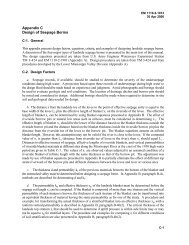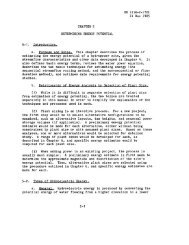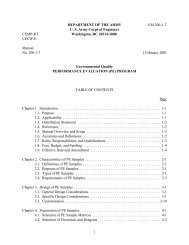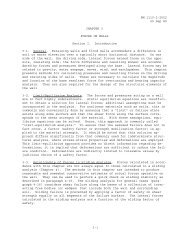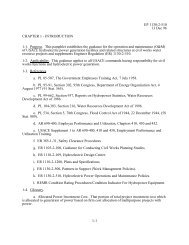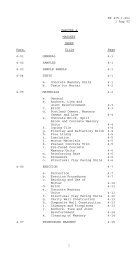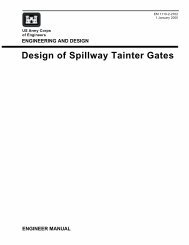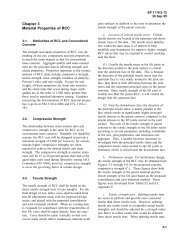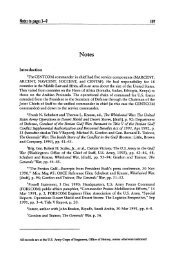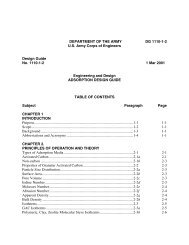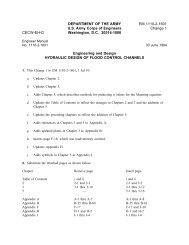Earthquake Design and Evaluation of Concrete Hydraulic Structures
Earthquake Design and Evaluation of Concrete Hydraulic Structures
Earthquake Design and Evaluation of Concrete Hydraulic Structures
You also want an ePaper? Increase the reach of your titles
YUMPU automatically turns print PDFs into web optimized ePapers that Google loves.
EM 1110-2-6053<br />
1 May 2007<br />
d. Fluid-structure interaction. A hydraulic structure <strong>and</strong> water interact through hydrodynamic<br />
pressures at the structure-water interface. In the case <strong>of</strong> concrete dams, the hydrodynamic<br />
pressures are affected by the energy loss at the reservoir boundary. The complete formulation<br />
<strong>of</strong> the fluid-structure interaction produces frequency-dependent terms that can be interpreted as<br />
an added force, an added mass, <strong>and</strong> an added damping (Chopra 1987). The added<br />
hydrodynamic mass influences the structure response by lengthening the period <strong>of</strong> vibration,<br />
which in turn changes the response spectrum ordinate <strong>and</strong> thus the earthquake forces. The<br />
added hydrodynamic damping arises from the radiation <strong>of</strong> pressure waves <strong>and</strong>, for dams, also<br />
from the refraction or absorption <strong>of</strong> pressure waves at the reservoir bottom. The added damping<br />
reduces the amplitude <strong>of</strong> the structure response especially at the higher modes. Hydrodynamic<br />
effects for concrete hydraulic structures including dams, locks, <strong>and</strong> intake towers are fully<br />
described in EM 1110-2-6051. If the water is assumed incompressible, hydrodynamic effects<br />
are simply represented by added mass coefficients. Depending on the level <strong>of</strong> sophistication<br />
needed the added hydrodynamic mass may be computed using Westergaard, velocity potential,<br />
or finite-element procedures (EM 1110-2-6051). For high dams refined dam-water interaction<br />
analysis including water compressibility <strong>and</strong> reservoir-boundary absorption effects may be<br />
required (Hall <strong>and</strong> Chopra 1980; Fenves <strong>and</strong> Chopra 1984b; Fok <strong>and</strong> Chopra 1985.<br />
e. Backfill-structure interaction effects. The interaction between the structure <strong>and</strong> backfill,<br />
<strong>and</strong> structure <strong>and</strong> surrounding water, as stated above, can be approximated using added mass<br />
concepts. It should be realized however, these interactions are complex <strong>and</strong> in some cases it<br />
may be necessary to use analytical methods, which deal with the interaction effects directly.<br />
Also important is the interaction between the structure <strong>and</strong> foundation. This interaction too is<br />
complex. In general, the effect <strong>of</strong> the foundation is to lengthen the fundamental period <strong>of</strong> the<br />
structure-foundation system, <strong>and</strong> to increase energy absorption due to energy radiation <strong>and</strong><br />
material damping that occurs in the foundation material.<br />
4-4. Effective Stiffness<br />
When analyzing concrete hydraulic structures for static loads, it is generally acceptable to use<br />
stiffness values associated with the un-cracked section properties <strong>and</strong> to ignore the stiffening<br />
contribution <strong>of</strong> reinforcing steel. However, under seismic loads it is important that distribution <strong>of</strong><br />
stresses <strong>and</strong> member forces be based on stiffness values that are representative <strong>of</strong> the near<br />
yield /cracking conditions. This is because the effective stiffness <strong>of</strong> CHS at near yield/cracking<br />
conditions can be significantly less than that represented by gross section properties. For<br />
reinforced concrete structures, the effective stiffness should be used in dynamic analyses to<br />
ensure that the hierarchy <strong>of</strong> member yielding conforms to assumed distributions, <strong>and</strong> that<br />
member plastic deformations are reasonably distributed through the structure. A reasonable<br />
estimate <strong>of</strong> the member stiffness is also required in computation <strong>of</strong> the structure period <strong>and</strong><br />
hence seismic forces <strong>and</strong> displacements.<br />
a. Plain concrete structures. Under severe earthquake ground shaking, it is probable that<br />
the elastic capacity <strong>of</strong> plain concrete structures such as gravity <strong>and</strong> arch dams would be<br />
exceeded, indicating some cracking with possible reduction in global stiffness <strong>of</strong> the structure. If<br />
cracking occurs near surfaces <strong>of</strong> these massive structures it will have minimal effects on the<br />
overall stiffness <strong>of</strong> the structure. Consequently in linear elastic analysis it is acceptable to use<br />
stiffness properties associated with the un-cracked sections. However, if cracking is pervasive<br />
<strong>and</strong> significant, its extent should be estimated <strong>and</strong> mapped so the stability <strong>of</strong> the cracked<br />
structure can be evaluated. Ideally, the evaluation should be conducted using nonlinear<br />
analyses if appropriate tools <strong>and</strong> procedures are available. Otherwise several approximate<br />
equivalent-linear analyses may be attempted, each with reduced stiffness <strong>and</strong> resistance<br />
4-14




